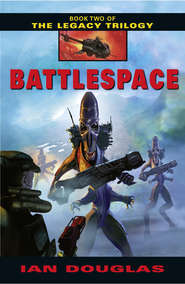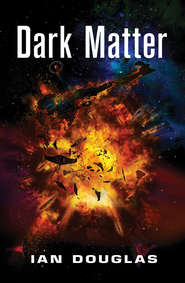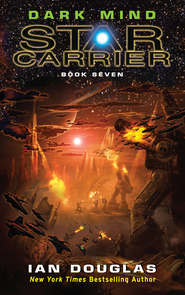По всем вопросам обращайтесь на: info@litportal.ru
(©) 2003-2024.
✖
The Star Carrier Series Books 1-3: Earth Strike, Centre of Gravity, Singularity
Настройки чтения
Размер шрифта
Высота строк
Поля
Collins wanted to make the trap side-by-side with Spaas. With her ship coming in just off Spaas’s forward quarter, he could check his alignment and vector by eye, and not have to rely so much on possibly malfunctioning sensors. Experienced pilots sometimes rode in with nuggets, or with other pilots experiencing instrumentation or thruster problems.
“Negative, Two.” Allyn switched to a private channel, so Spaas wouldn’t hear. “Damn it, Collie-dog, I don’t want to lose both of you if this goes bad.”
“Acknowledged.” Collins’ voice was tight, the word bitten off and hard.
Allyn switched back to the squadron channel. “Final turn, people. Let’s do it by the book.”
The America was still invisibly distant, some eight thousand kilometers up ahead. Their dustcatchers jettisoned, the fighters used brief applications of their singularities to align themselves precisely with the ship, then switched them off. The carrier was traveling directly away from them at ten kilometers per second, accelerating at fifty gravities, which increased its velocity by half a kilometer per second every second. The fighters were coming in faster, but slowing; by the time they were a hundred kilometers off America’s tail, they would be moving just three hundred meters per second faster than the carrier.
“VFA-44, you are cleared for trap. Landing Bay Two.”
“Dragon One. Copy.”
“Switch to AI approach,” she said.
“Confirmed,” her computer said. “AI in control of final approach.”
When everything was working right, the computer network between fighter and carrier did a much better job of nudging the ship into the aft opening of a rotating landing bay.
The AI triggered a five hundred grav singularity aft, braking her sharply, just as the America appeared ahead, rapidly swelling in apparent size. The singularity snapped off when she was moving just three hundred meters per second relative to the America.
The carrier looked so damned tiny, a hard-edged toy almost lost among stars and empty night.
And then the carrier’s aft end swelled to fill half the sky and she was into her trap.
Moments before, the carrier had switched off her own grav drive, simplifying the complex ballet balancing velocity and distance. Though conventions like up and down and above and below didn’t exist in free fall, the fighter’s attitude on final suggested that she was skimming in just beneath the vessel’s huge, aft quantum tap power module, the dark, silver-gray metal of the hull blurring past just above her head. Ahead, Landing Bay Two slowly swung in from the right.
The carrier’s hab modules were stacked around America’s spine, like layers in a cake, bent into a disk nestled in behind the mushroom-cap shield. The modules were in constant rotation, creating a steady out-is-down artificial gravity. A rotation of 2.11 turns per minute created the feeling of half a G at the outer rim, one hundred meters from the ship’s spine. A point on the outside rim was moving at twenty-two meters per second, or nearly fifty miles per hour.
The carrier could stop the module rotation, but that created chaos on board, as every crew member, every tool or coffee cup or personal item not fastened down drifted away, weightless. And there was an easier solution.
The landing bay was at the bottom of the stack, closest to the ship’s spine. The rotation of 2.11 turns per minute with a radius of just thirty meters created an apparent gravity of just .15 G—a shade less than the surface gravity of Earth’s moon—but it meant that the turning landing bay was moving at less than seven meters per second.
At the last instant, the AI fired the fighter’s starboard-side thrusters, giving Allyn’s Starhawk a sideways kick to its vector of seven meters per second. For just an instant, the broad landing bay opening appeared to freeze motionless ahead … and then Allyn flashed past the lines of acquisition lights and into the opening.
Where gravitational acceleration or deceleration acted uniformly on both fighter and pilot, making maneuvers feel like free fall, this was altogether different. The tangleweb field invisibly enmeshed the incoming fighter and dragged it down from a relative 300 meters per second to a relative velocity of zero in the space of three hundred fifty meters.
The Starhawk came to rest, and Allyn sagged back against her seat, her vision slowly swimming back to normal after the brutal seven-G decel. Magnetic grapnels unfolded from the overhead, moving her forward and out of the way of the next incoming Starhawk, thirty seconds behind her. They moved her to one of a dozen deck hatches covered over by the liquid-looking black of an atmospheric nanoseal, lowering her smoothly through the clinging seal and into the air and light of the fighter recovery deck. The grapnels deposited her atop an elevator column and released; the column began sinking into the deck, lowering her to the fifty-meter radius level. As she descended, the hab’s spin gravity steadily rose from fifteen hundredths of a G to a more respectable one-quarter gravity.
By the time the elevator column sank into the deck and the cockpit of her fighter melted open around her, Tucker had already trapped and was beginning her descent to the recovery deck, while Collins was in the last ten seconds of her approach.
And Spaas was inbound on final, thirty seconds behind her.
Allyn climbed out of the cockpit and down to the deck, her knees unsteady after seven Gs. “Welcome home, Commander!” a crew chief told her. She nodded and walked aft, unsealing her bubble helmet and tucking it beneath her arm.
An enormous repeater viewall filled much of the aft bulkhead of the recovery deck, large enough to be seen from any part of the cavernous compartment. It showed a camera view looking aft from inside the landing bay, the wide entrance curving upward slightly in a gentle smile, the aft end of the carrier extending back into space from overhead, the stars beyond gently swinging in a slow circle around the carrier’s vanishing point as the hab module continued to rotate. Numbers at the top left of the screen, in green, showed Collins’ approach velocity—282 mps. A second number counted down the seconds to trap: six … five … four …
And then Collins’ gravfighter was there, appearing out of the night as if by magic, hurtling through the landing deck’s maw and slowing abruptly as it entered the compartment’s tangleweb field. The fighter vanished off the side of the screen almost immediately, but a green light winked on above the viewall, signaling a successful trap.
Thirty seconds more to Spaas’ arrival.
She could hear the voice of America’s LSO-AI, a machine intelligence tasked with coordinating incoming fighters with the moving landing deck. LSO was an ancient term going back to the era of seaborne aircraft carriers four centuries before—an acronym for landing signals officer. The job was no longer held by humans; machines were far faster and more precise. Since the LSO-AI was actually handling the incoming gravfighter’s controls, the voice was for the benefit of human observers.
“Vector left … vector left … stabilize … vector left …”
The “vector left” was the LSO attempting to fire the fighter’s starboard thrusters, to match its incoming vector with the seven-meter-per-second rotation of the landing bay. The numerals on the screen were red, showing an approach velocity of 348 mps, too fast, too fast, as the countdown dwindled from seven … to six …
“Gravfighter outside safe approach parameters,” the LSO announced, the voice cold and unemotional. The green light above the opening flashed red.
Allyn’s heart was pounding. Oh, God, no …
“Abort,” the LSO voice continued, impassive, “abort … abort …”
Spaas’ Starhawk appeared, but too far to the left, much too far to the left, and coming in too fast. His ship was dead; he couldn’t abort, couldn’t fire a ventral singularity to warp his course into a vector that would miss the rotating landing bay and the underside of America’s huge cap beyond.
The incoming fighter almost made it. …
Spaas’ gravfighter clipped the trailing edge of the entranceway. Sparks erupted, and then the Starhawk’s starboard side disintegrated in peeling, fragmenting metal. The port side flipped into an out-of-control tumble, vanishing off the right side of the screen. The light above the bay flashed red.
Allyn could feel the ship crews around her sag as Spaas died—no one could have survived such a crash. They sagged, they turned away. She heard someone nearby mutter, “Shit …”
Allyn said nothing. Gripping her helmet tightly, she turned away and started walking toward the recovery deck elevators.
She had a report to file, a debriefing to endure.
She felt exhausted and bruised, and every step dragged at her like death.
Squadron Ready Room
TC/USNA CVS America
Outbound, Eta Boötis System
2022 hours, TFT
Gray stared at the ready room repeater screen, unable to tear his eyes away. It was one thing when a squadron mate bought it in a clean, silent flash of light out in space, quite another when you watched them zorch in for a trap and miss the sweet spot by a matter of scant meters.
He didn’t like Spaas. In fact, he’d detested the guy—an arrogant bully, a womanizer, as much the elitist hypocrite as his partner, Collins.
He’d still been family.
Numb, Gray ran through the members of the Dragonfires, startled to realize that where twelve had launched from the America out in the local Kuiper Belt early yesterday morning, only four, counting himself, were left. Sixty-six percent casualties was devastating for any military unit; when the unit was as small as a squadron to begin with, with members practically living in one another’s pockets, the sense of family was keener still … even when you couldn’t stand the bastards.
He wondered if the Dragonfires would be disbanded, the survivors sent as replacements to other squadrons.
The hell with it, He found he didn’t care right now one way or another, didn’t care about anything.
But an audio alarm caught his attention, and he switched the display screen to tactical.











